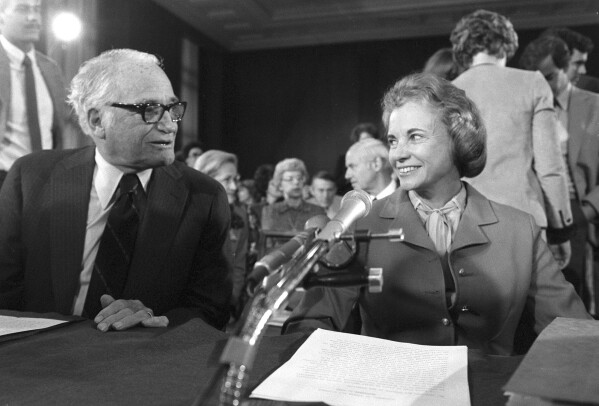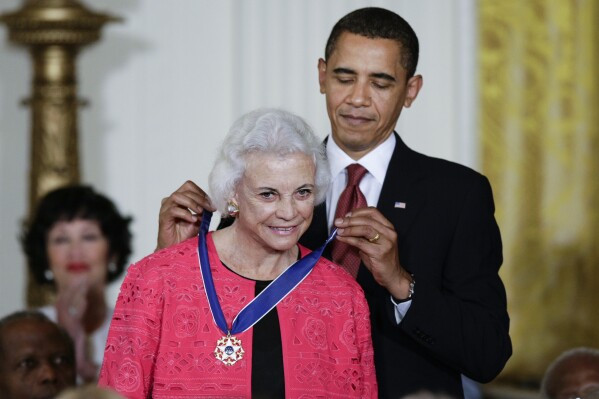Making History
During the final month of the 1980 presidential campaign, candidate Ronald Reagan needed more support from female voters. He stated that if he were elected, he would appoint a woman to the U.S. Supreme Court. In July 1981, President Reagan kept his promise and nominated Sandra Day O'Connor. Described by Reagan as a “person for all seasons,” O’Connor was confirmed unanimously by the Senate and was sworn in as the first female justice on September 25, 1981. Thus, Sandra Day O’Connor became the first female justice in the 191 year history of the Supreme Court. At the time she was nominated, she became the first person appointed to the nation’s court in 24 years who had state court experience and the first justice in 32 years with lawmaking experience, having served in the state legislature.

Sen. Barry Goldwater, R-Ariz., and Sandra Day O’Connor, talk prior to the start of her confirmation hearings before the Senate Judiciary Committee, Sept. 9, 1981.
During her remarkable Supreme Court tenure, which spanned nearly a quarter century, O’Connor played a crucial role in many key decisions and was highly regarded an independent thinker and a leader on the court. O’Connor quickly became known for her pragmatism and was considered, with Justice Anthony Kennedy, a decisive swing vote in the Supreme Court’s decisions. In such disparate fields as election law and abortion rights, she attempted to fashion workable solutions to major constitutional questions, often over the course of several cases. In her decisions in election law she emphasized the importance of equal-protection claims (Shaw v. Reno [1993]), declared unconstitutional district boundaries that are “unexplainable on grounds other than race” (Bush v. Vera [1996]), and sided with the Court’s more liberal members in upholding the configuration of a congressional district in North Carolina created on the basis of variables including but not limited to race (Easley v. Cromartie [2001]).
In similar fashion, O’Connor’s views on abortion rights were articulated gradually. In a series of rulings, she signaled a reluctance to support any decision that would deny women the right to choose a safe and legal abortion. By “defecting” in part from the conservative majority in Webster v. Reproductive Health Services (1989)—in which the Court upheld a Missouri law that prohibited public employees from performing or assisting in abortions not necessary to save a woman’s life and that required doctors to determine the viability of a fetus if it was at least 20 weeks old—she reduced the Court’s opinion to a plurality. Through her stewardship in Planned Parenthood of Southeastern Pennsylvania v. Casey (1992), the Court refashioned its position on the right to abortion. The Court’s opinion, which O’Connor wrote with Justices Anthony Kennedy and David Souter, reaffirmed the constitutionally protected right to abortion established in Roe v. Wade (1973) but also lowered the standard that legal restrictions on abortion must meet in order to pass constitutional muster. After Casey, such laws would be considered unconstitutional only if they constituted an “undue burden” on women seeking to obtain an abortion.
O’Connor could, nonetheless, express her views tartly. In one of her final actions as a justice, a dissent to a 5-4 ruling to allow local governments to condemn and seize personal property to allow private developers to build shopping plazas, office buildings and other facilities, she warned that the majority had unwisely ceded yet more power to the powerful. “The specter of condemnation hangs over all property,” O’Connor wrote. “Nothing is to prevent the state from replacing . . . any home with a shopping mall, or any farm with a factory.”
On the bench, O’Connor generally favored states in disputes with the federal government. She often sided with police when they faced claims of violating people’s rights. In 1985, she wrote for the court as it ruled that the confession of a criminal suspect first warned about his rights may be used as trial evidence, even if police violated the suspect’s rights in obtaining an earlier confession.
A 1991 decision written by O’Connor said police do not violate the Constitution’s ban against unreasonable searches and seizures when they board buses and randomly ask passengers to consent to being searched. In a 1994 decision, O’Connor said police officers need not stop questioning and seek clarification when a criminal suspect makes what might have been an ambiguous request for legal help.
O’Connor wrote for the court in 1992, when it said prison guards violate inmates’ rights by using unnecessary physical force even if no serious injuries result, and in 1993, when it ruled that employers may be guilty of illegal sexual harassment even in the absence of any psychological harm.
In 2004, O’Connor wrote the majority opinion that went against the Bush administration in ruling that an American citizen seized on the Afghanistan battlefield can challenge his detention in U.S. courts. “We have long since made clear that a state of war is not a blank check for the President when it comes to the rights of the Nation’s citizens,” O’Connor wrote.

President Barack Obama presents the 2009 Presidential Medal of Freedom to Sandra Day O’Connor, Aug. 12, 2009.
During the commencement speech she gave at Stanford in 2004, she reflected on her appointment by President Reagan:
His decision was as much a surprise to me as it was to the nation as a whole. But Ronald Reagan knew that his decision wasn’t about Sandra Day O’Connor; it was about women everywhere. It was about a nation that was on its way to bridging a chasm between genders that had divided us for too long.
The enormity of the reaction to O’Connor’s appointment had surprised her. She received more than 60,000 letters in her first year, more than any one member in the court’s history. “I had no idea when I was appointed how much it would mean to many people around the country,” she once said. “It affected them in a very personal way. People saw it as a signal that there are virtually unlimited opportunities for women. It’s important to parents for their daughters, and to daughters for themselves.” Reflecting the trailblazing nature of her career, only two percent of law students were women at the time she attended in the 1950s. By the time she retired in 2006, that percentage had risen to forty-eight percent. Justice Ketanji Brown Jackson said O’Connor “helped pave the road on which other jurists, including me, now walk.” Justice Elena Kagan said O’Connor judged with wisdom and “a will to promote balance and mutual respect in this too-often divided country.” George Bush praised her as “a discerning and conscientious judge and a public servant of complete integrity.”
O’Connor retired on January 31, 2006. Following her retirement, O’Connor expressed regret that a woman had not been chosen to replace her. O’Connor remained active in the government even after she retired from the court. She sat as a judge on several federal appeals courts, advocated for judicial independence and served on the Iraq Study Group. She also was appointed to the honorary post of chancellor at the College of William and Mary in Virginia.